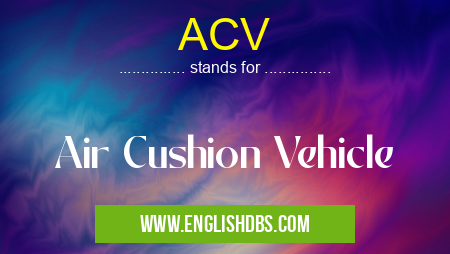What does ACV mean in MILITARY
An Air Cushion Vehicle (ACV) is a vehicle designed to travel on a cushion of air generated either by an engine-driven fan, or by the aerodynamic lift generated as the vehicle moves forward. It is sometimes referred to as a hovercraft, although that term is more properly used to describe vehicles operating on both land and sea. ACVs have been used for transport, military operations, search and rescue missions, and recreational activities for decades. The most common types of ACV are amphibious vehicles, which can be used both on land and water.

ACV meaning in Military in Governmental
ACV mostly used in an acronym Military in Category Governmental that means Air Cushion Vehicle
Shorthand: ACV,
Full Form: Air Cushion Vehicle
For more information of "Air Cushion Vehicle", see the section below.
» Governmental » Military
Working Principle
The primary principle behind an ACV is simple; air from the fan or from the thrusters beneath it is pushed down through one or more ducts in the bottom of the hovercraft to form a cushion beneath the vehicle. This cushion provides buoyancy, allowing it to float above any surface it finds itself over – including water. The cushion also functions as a shock absorber when driving over rough terrain or debris; providing improved ride comfort when compared to traditional wheeled vehicles. Additionally, since no contact between the ground and ACV's hull exists other than via wake turbulence created by the engines’ output jets, there is significantly reduced friction between them and thus improved fuel efficiency and increased top speeds.
Advantages
The introduction of air cushioned vehicles has brought many advantages with them that were not available with traditional wheeled vehicles: • They are capable of travelling over a variety of terrains with relatively little effort – including mud, shallow water bodies and sand dunes - where-as traditional wheels often become bogged down in such circumstances making them almost impossible to traverse with efficient speed; • By using air pressure rather than relying on wheels for traction they also provide improved stability compared to their wheeled counterparts; • The lack of physical connection between the ground and hull reduces noise pollution; • Reduced operational costs due to lower fuel consumption; • Increased maneuverability; • Enhanced navigational capabilities even through extremely tight areas such as jungles which may otherwise be inaccessible.
Essential Questions and Answers on Air Cushion Vehicle in "GOVERNMENTAL»MILITARY"
What is an Air Cushion Vehicle (ACV)?
An ACV is a type of vehicle that utilizes an air cushion created by fans or rotors to move over various surfaces such as water, ice and even land. These vehicles are powered by engines and jet propulsion that provide the necessary lift and thrust for movement.
What are the advantages of using an ACV?
ACVs have several advantages over regular vehicles, including being faster than most boats, and having greater maneuverability on land. They can also travel very smoothly on both land and water without creating large waves, allowing them to navigate tight areas with ease.
Is it safe to ride in an ACV?
Absolutely! All models are designed with safety features in mind such as fully enclosed cabins, rollover protection systems and multiple independent buoyancy chambers which all help reduce the risk of injury or accidents occurring when on-board.
Is it easy to operate an ACV?
Yes! Generally speaking, any experienced driver who knows how to operate a boat should be able to handle an ACV relatively easily with some basic instruction. It’s important to remember though that each model has different operating requirements so careful read of the user manual is recommended before taking off for the first time.
How much does an ACV cost?
The price of an ACV can vary significantly depending on make and model. Generally speaking though they tend to start around the $30,000 mark for a basic model moving up from there depending on your needs and desires.
What type of fuel do ACVs run on?
Most modern-day ACVs run on standard unleaded gasoline although some larger types may require more specialized fuels due to their higher power outputs. Always check your user manual carefully before fuelling up!
Can I drive my own Air Cushion Vehicle?
Yes you can provided you meet all local regulations regarding recreational boating and have undergone relevant training prior to operation.
Are there any age restrictions for driving an Air Cushion Vehicle?
In many countries around the world there is no fixed age limit however its always best practice to check locally as specific rules may apply depending where you are located.
Final Words:
Air Cushion Vehicles offer unparalleled capabilities for travel over all sorts of surfaces which make them invaluable tools in many situations ranging from military operations through transportation services like airlines all the way up to casual recreational activities such as leisurely drives across beaches or riverside expeditions. Thanks to their superior navigational abilities combined with fuel efficiency and low environmental impact potential these amazing machines offer an excellent alternative for those looking for something out of ordinary means of transport.
ACV also stands for: |
|
| All stands for ACV |
